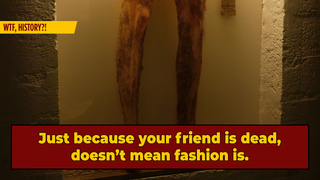Medieval Iceland's Darkest Fashion Trend: Necropants

When going out for a night on the fjords, you want to wear something that makes you affluent, powerful, sleek, and sexy. If so, the sartorial sorcerers of Iceland have just the pair of pants for you, ones which won't just ooze wealth but feel as comfortable as a second skin.
That is if you don't mind actually wearing a second skin. Life in 17th century Iceland wasn't easy for the common folk, and their dark arts reflect that. Instead of Nordic sigils to conjure up devils and firestorms, Icelandic "staves" were of a much more practical sort: warding off foxes, gathering more fishes, and protecting peasants from the evils of cursed butter. But the most flamboyant (and desperate) sigil had to be the one used in the creation of a nabrok, or necropants, a bespoke set of human-skin trousers that could make you richer than your wildest beliefs.

The practice of necropants-making (not to be confused with necropantsing, the popular postmortem prank) was a dark deed based on the best of intentions. What you needed to do was ask your best friend if it was cool if, after their demise, you dug up their corpse in the middle of the night, flay the skin off of their bottom half and then wear it as a jaunty pair of pantaloons. If the answer was a jolly "yes," you had to skin your bestie in a way that left the legs completely intact, except for the scrotum, which was to be turned into a literal coin purse, housing the nabrok sigil and a single Icelandic krona coin robbed from the grieving widow.
Don't Miss
This was the necropants' true purpose, a scrotal cash machine giving the wearer a happy ending by continuously jizzing out more and more money. But becoming a slave to the Devil's fashion did come with its downsides. Nabrok wearers faced the danger of being caught with their necropants down -- or up, to be more specific. For if a necropants wearer died with the skin-tight skin still wrapped around their legs, their body would be devoured by lice and their soul be sent to hell. The only way to escape that fate was to, before you put one foot in the grave, convince someone else to put one leg into your necropants. This would transfer both the scrote-curse and the scrote-blessing to the new wearer and allow many generations to prosper off these human hand-me-downs.

Of course, the real question with fleshy folklore like this is: Did anyone ever really make a pair of necropants? We'll likely never know, as it's hard enough to keep a pair of Levi's intact for four hundred years, let alone a pair of pants made from your best mate Levi. There is one Icelander on record to have been accused of sartorial Satanism: Mensalder Jonsson, or Mensalder The Rich. His jealous neighbors blamed the Uncle Money-ballbags for the sinister practice of voluntarily putting on flesh pants and then becoming mad (sure, 'becoming'). But with no surviving (or existing) necropants to be found, only a replica can be found in The Museum of Icelandic Sorcery & Witchcraft. That it's the richest museum in the world is surely a coincidence.
For more witchy tangents, do follow Cedric on Twitter.
Top Image: Bensisto